Color in Chinese culture
- 格式:doc
- 大小:28.50 KB
- 文档页数:2
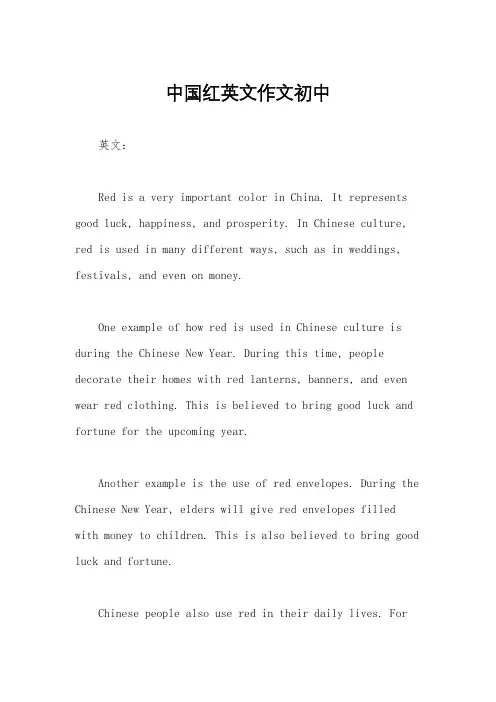
中国红英文作文初中英文:Red is a very important color in China. It represents good luck, happiness, and prosperity. In Chinese culture, red is used in many different ways, such as in weddings, festivals, and even on money.One example of how red is used in Chinese culture is during the Chinese New Year. During this time, people decorate their homes with red lanterns, banners, and even wear red clothing. This is believed to bring good luck and fortune for the upcoming year.Another example is the use of red envelopes. During the Chinese New Year, elders will give red envelopes filled with money to children. This is also believed to bring good luck and fortune.Chinese people also use red in their daily lives. Forexample, they may wear red clothing to important events such as weddings or job interviews. They may also give gifts wrapped in red paper to show their good intentions.Overall, red is a very important color in Chinese culture and is used in many different ways to bring good luck and happiness.中文:红色在中国文化中是非常重要的颜色。
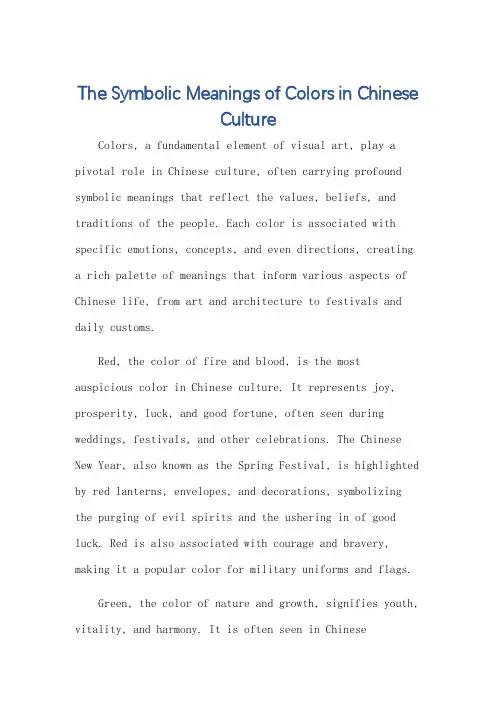
The Symbolic Meanings of Colors in ChineseCultureColors, a fundamental element of visual art, play a pivotal role in Chinese culture, often carrying profound symbolic meanings that reflect the values, beliefs, and traditions of the people. Each color is associated with specific emotions, concepts, and even directions, creating a rich palette of meanings that inform various aspects of Chinese life, from art and architecture to festivals and daily customs.Red, the color of fire and blood, is the most auspicious color in Chinese culture. It represents joy, prosperity, luck, and good fortune, often seen during weddings, festivals, and other celebrations. The Chinese New Year, also known as the Spring Festival, is highlighted by red lanterns, envelopes, and decorations, symbolizing the purging of evil spirits and the ushering in of good luck. Red is also associated with courage and bravery, making it a popular color for military uniforms and flags. Green, the color of nature and growth, signifies youth, vitality, and harmony. It is often seen in Chineselandscapes, paintings, and gardens, where it represents the balance between man and nature. Green is also associated with peace and prosperity, often used in temples and altars to symbolize the union of heaven and earth.White, the color of purity and cleanliness, is highly valued in Chinese culture. It represents purity, innocence, and respect, often seen in the robes of priests, monks, and other religious figures. White is also associated with death and mourning, often seen in funeral rites and memorials.Black, the color of night and mystery, is associated with darkness, negativity, and death in Chinese culture. However, it is also seen as a symbol of authority and dignity, often worn by government officials and scholars. Black is also believed to have protective properties, often used in talismans and amulets.Yellow, the color of the earth and the sun, is considered the supreme color in Chinese imperial culture.It represents royalty, dignity, and sacredness, often seen in the robes and banners of emperors and high-rankingofficials. Yellow is also associated with wisdom and learning, often seen in temples and monasteries.Blue, the color of sky and sea, represents tranquility, peace, and loyalty in Chinese culture. It is often seen in paintings and landscapes, where it symbolizes the vastness and infinity of nature. Blue is also associated with wisdom and intelligence, often used in decoration and furnishings. Purple, a rare and expensive color in ancient China, was considered a symbol of luxury and nobility. It represents majesty, dignity, and wisdom, often seen in the robes and accessories of high-ranking officials and nobles. Purple is also associated with the heavens and divinity, often seen in religious paintings and sculptures.In conclusion, colors in Chinese culture carry rich symbolic meanings that reflect the values, beliefs, and traditions of the people. Each color is associated with specific emotions, concepts, and directions, creating a unique visual language that informs various aspects of Chinese life. From red's association with joy andprosperity to black's symbolism of authority and dignity, the symbolic meanings of colors in Chinese culture offer aprofound understanding of the values and beliefs that shape this rich and diverse society.**中华文化中颜色代表的含义**颜色作为视觉艺术的基本要素,在中华文化中扮演着举足轻重的角色,常常承载着深厚的象征意义,反映了中国人民的价值观、信仰和传统。
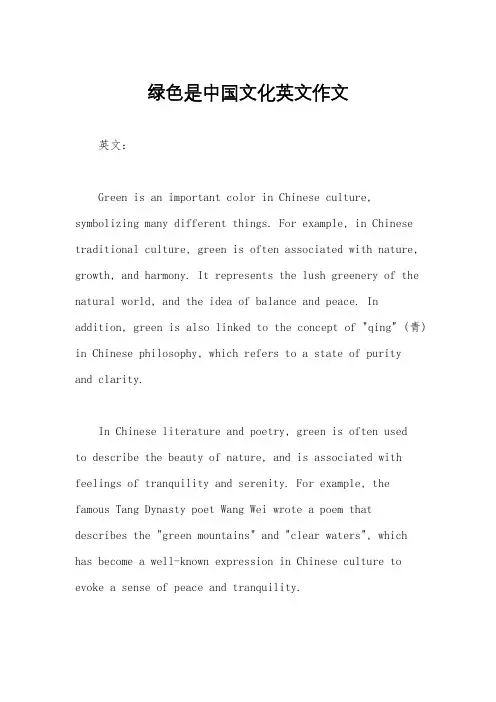
绿色是中国文化英文作文英文:Green is an important color in Chinese culture, symbolizing many different things. For example, in Chinese traditional culture, green is often associated with nature, growth, and harmony. It represents the lush greenery of the natural world, and the idea of balance and peace. In addition, green is also linked to the concept of "qing" (青) in Chinese philosophy, which refers to a state of purityand clarity.In Chinese literature and poetry, green is often usedto describe the beauty of nature, and is associated with feelings of tranquility and serenity. For example, the famous Tang Dynasty poet Wang Wei wrote a poem that describes the "green mountains" and "clear waters", which has become a well-known expression in Chinese culture to evoke a sense of peace and tranquility.Furthermore, in traditional Chinese medicine, green is associated with the liver and the wood element. It is believed that the color green can have a calming and soothing effect on the body and mind. For example, when someone is feeling stressed or anxious, they may be advised to spend time in nature surrounded by greenery to help restore balance and harmony.中文:绿色在中国文化中具有重要的意义,象征着许多不同的东西。
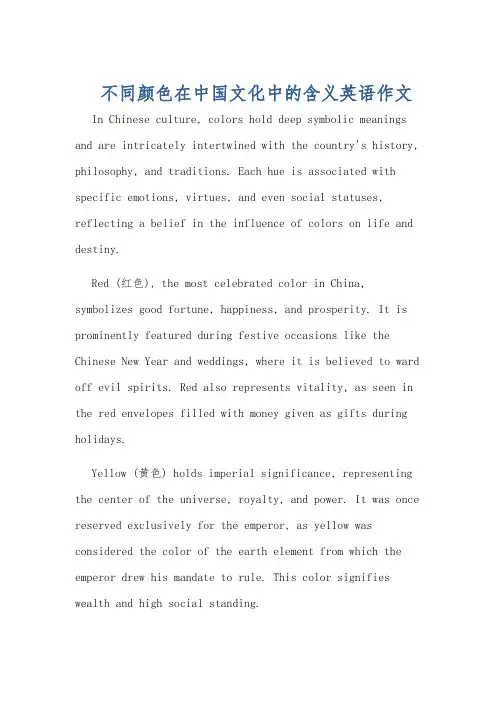
不同颜色在中国文化中的含义英语作文In Chinese culture, colors hold deep symbolic meanings and are intricately intertwined with the country's history, philosophy, and traditions. Each hue is associated with specific emotions, virtues, and even social statuses, reflecting a belief in the influence of colors on life and destiny.Red (红色), the most celebrated color in China, symbolizes good fortune, happiness, and prosperity. It is prominently featured during festive occasions like the Chinese New Year and weddings, where it is believed to ward off evil spirits. Red also represents vitality, as seen in the red envelopes filled with money given as gifts during holidays.Yellow (黄色) holds imperial significance, representing the center of the universe, royalty, and power. It was once reserved exclusively for the emperor, as yellow was considered the color of the earth element from which the emperor drew his mandate to rule. This color signifies wealth and high social standing.Green (绿色), associated with nature and growth,signifies harmony, health, and fertility. It embodies the rejuvenating qualities of spring and is often used todepict youth and new beginnings.Blue (蓝色), though less prominent than red and yellow, symbolizes trustworthiness, longevity, and immortality. In traditional Chinese art, blue is frequently used to depict water and the vast sky, symbolizing serenity and purity.White (白色), unlike Western cultures where itrepresents purity and innocence, is associated with mourning and death in China. It symbolizes spiritual purity and is worn at funerals to show respect for the deceased.Black (黑色), though sometimes viewed as ominous, also signifies elegance, stability, and sophistication. It is used in formal settings and represents the element of water, embodying wisdom and mystery.In summary, colors in Chinese culture carry profound meanings that extend beyond aesthetics. They serve as a language of symbolism, reflecting the values, beliefs, and aspirations of the Chinese people.---在中国文化中,色彩承载着深厚的文化寓意,与中国的历史、哲学及传统紧密相连。
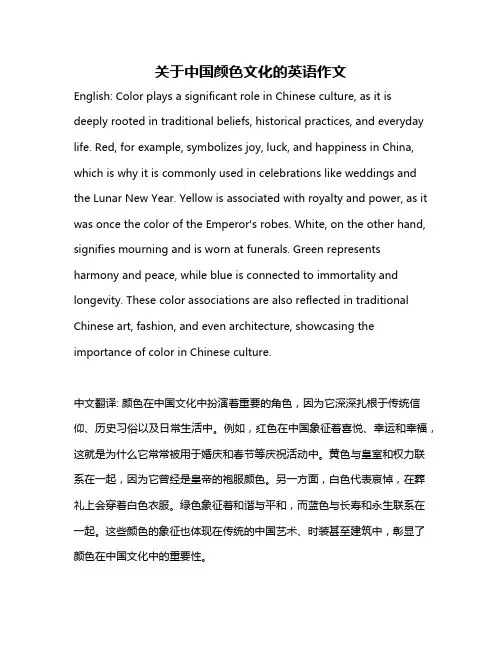
关于中国颜色文化的英语作文English: Color plays a significant role in Chinese culture, as it is deeply rooted in traditional beliefs, historical practices, and everyday life. Red, for example, symbolizes joy, luck, and happiness in China, which is why it is commonly used in celebrations like weddings and the Lunar New Year. Yellow is associated with royalty and power, as it was once the color of the Emperor's robes. White, on the other hand, signifies mourning and is worn at funerals. Green represents harmony and peace, while blue is connected to immortality and longevity. These color associations are also reflected in traditional Chinese art, fashion, and even architecture, showcasing the importance of color in Chinese culture.中文翻译: 颜色在中国文化中扮演着重要的角色,因为它深深扎根于传统信仰、历史习俗以及日常生活中。
例如,红色在中国象征着喜悦、幸运和幸福,这就是为什么它常常被用于婚庆和春节等庆祝活动中。
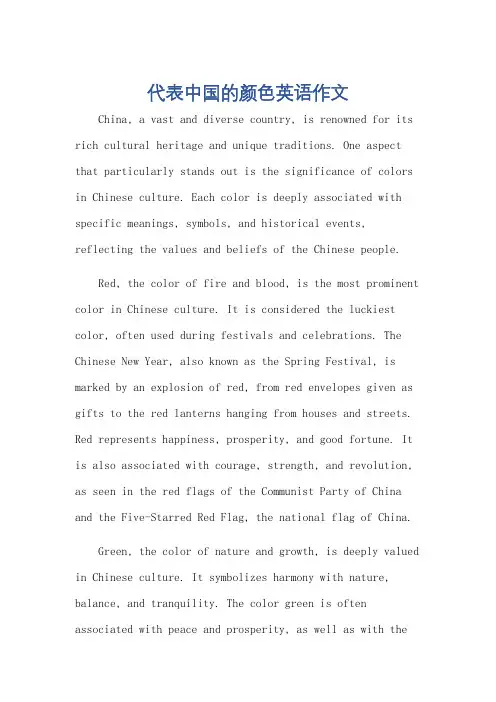
代表中国的颜色英语作文China, a vast and diverse country, is renowned for its rich cultural heritage and unique traditions. One aspect that particularly stands out is the significance of colors in Chinese culture. Each color is deeply associated with specific meanings, symbols, and historical events, reflecting the values and beliefs of the Chinese people.Red, the color of fire and blood, is the most prominent color in Chinese culture. It is considered the luckiest color, often used during festivals and celebrations. The Chinese New Year, also known as the Spring Festival, is marked by an explosion of red, from red envelopes given as gifts to the red lanterns hanging from houses and streets. Red represents happiness, prosperity, and good fortune. It is also associated with courage, strength, and revolution, as seen in the red flags of the Communist Party of China and the Five-Starred Red Flag, the national flag of China. Green, the color of nature and growth, is deeply valued in Chinese culture. It symbolizes harmony with nature, balance, and tranquility. The color green is often associated with peace and prosperity, as well as with thehope of new beginnings. In ancient China, green was also considered a symbol of loyalty and righteousness.Yellow, the color of the earth and sun, holds a special place in Chinese history and tradition. It was the color of the robes worn by the emperors of the Imperial China, symbolizing their divine right to rule. Yellow represents imperial power, dignity, and wisdom. In modern times, yellow has also become a symbol of the Chinese people, asit is the color of the national flag of the People's Republic of China.White, the color of purity and innocence, is also significant in Chinese culture. It is often associated with death and mourning, but also represents purity, simplicity, and cleanliness. White is used in traditional Chinese wedding dresses, symbolizing the purity and innocence of the bride. It is also seen in the decoration of temples and altars, where it represents purity and respect.Black, the color of night and mystery, is less frequently used in Chinese culture than other colors. However, it still holds a place of importance, representing formality, elegance, and authority. Black is oftenassociated with wisdom and learning, as well as with death and mourning. In ancient China, black was also considered a symbol of loyalty and righteousness.The colors of China are not just simple hues; they are deeply rooted in the history, culture, and traditions ofthe country. They represent the values, beliefs, and aspirations of the Chinese people, making them an integral part of the national identity. From red to green, yellow to white, and black, each color tells a story of China's rich and diverse heritage.**中国之色:象征之旅**中国,这个广袤而多元的国家,以其丰富的文化遗产和独特的传统而著称。
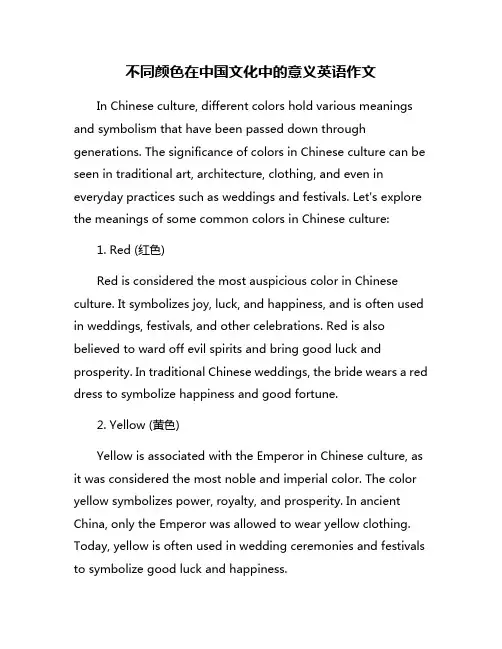
不同颜色在中国文化中的意义英语作文In Chinese culture, different colors hold various meanings and symbolism that have been passed down through generations. The significance of colors in Chinese culture can be seen in traditional art, architecture, clothing, and even in everyday practices such as weddings and festivals. Let's explore the meanings of some common colors in Chinese culture:1. Red (红色)Red is considered the most auspicious color in Chinese culture. It symbolizes joy, luck, and happiness, and is often used in weddings, festivals, and other celebrations. Red is also believed to ward off evil spirits and bring good luck and prosperity. In traditional Chinese weddings, the bride wears a red dress to symbolize happiness and good fortune.2. Yellow (黄色)Yellow is associated with the Emperor in Chinese culture, as it was considered the most noble and imperial color. The color yellow symbolizes power, royalty, and prosperity. In ancient China, only the Emperor was allowed to wear yellow clothing. Today, yellow is often used in wedding ceremonies and festivals to symbolize good luck and happiness.3. Green (绿色)Green represents harmony, growth, and peace in Chinese culture. It is also associated with nature, fertility, and health. Green is often used in traditional Chinese medicine and healing practices to promote balance and wellness. Jade, a precious green stone, is highly valued in Chinese culture for its symbolism of purity and protection.4. Blue (蓝色)Blue is associated with the element of water in Chinese culture, symbolizing tranquility, wisdom, and purity. Blue is often used in traditional Chinese art and design to create a sense of calm and serenity. In feng shui, blue is believed to bring a sense of clarity and relaxation to a space.5. White (白色)White symbolizes purity, truth, and simplicity in Chinese culture. It is often used in funerals and mourning ceremonies to symbolize the purity of the deceased's soul. White is also associated with cleanliness and new beginnings. In traditional Chinese weddings, the bride often wears white to symbolize purity and innocence.6. Black (黑色)Black is associated with darkness, mystery, and power in Chinese culture. It is often used in traditional Chinese calligraphy and ink painting to create contrast and depth. Black is also considered a color of protection and is believed to ward off negative energy. In fashion, black is a versatile and timeless color that symbolizes elegance and sophistication.Overall, colors play a significant role in Chinese culture, conveying rich symbolism and meanings that are deeply rooted in tradition and history. Understanding the significance of colors in Chinese culture can enhance our appreciation of art, design, and cultural practices. By embracing the diverse meanings of colors, we can cultivate a deeper understanding and connection to the vibrant tapestry of Chinese culture.。
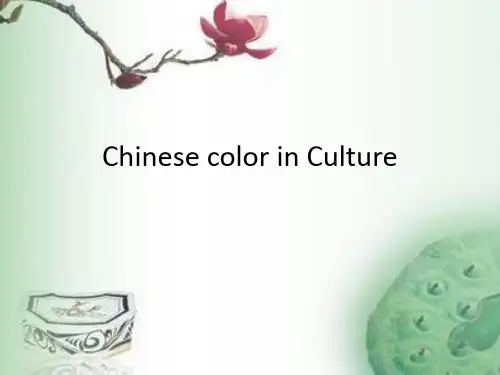
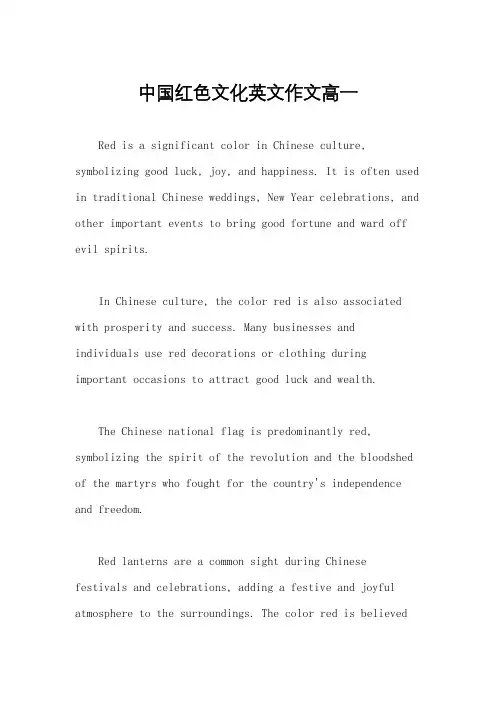
中国红色文化英文作文高一Red is a significant color in Chinese culture, symbolizing good luck, joy, and happiness. It is often used in traditional Chinese weddings, New Year celebrations, and other important events to bring good fortune and ward off evil spirits.In Chinese culture, the color red is also associated with prosperity and success. Many businesses andindividuals use red decorations or clothing during important occasions to attract good luck and wealth.The Chinese national flag is predominantly red, symbolizing the spirit of the revolution and the bloodshed of the martyrs who fought for the country's independence and freedom.Red lanterns are a common sight during Chinesefestivals and celebrations, adding a festive and joyful atmosphere to the surroundings. The color red is believedto bring people together and create a sense of unity and harmony.In traditional Chinese opera, actors wear elaborate costumes with red as the dominant color, representing courage, loyalty, and righteousness. The use of red in the costumes helps to convey the characters' emotions and personalities to the audience.The Chinese zodiac assigns each year a specific animal and element, and red is often associated with the Fire element. People born in a Fire year are believed to be passionate, energetic, and courageous, reflecting the characteristics of the color red.In Chinese art and calligraphy, red ink is often used to write auspicious words and phrases, such as "happiness," "fortune," and "prosperity." The use of red ink is believed to bring good luck and blessings to the writer and the recipient of the artwork.In summary, red holds a special place in Chineseculture, representing good fortune, prosperity, and happiness. Its significance can be seen in various aspects of Chinese life, from celebrations and traditions to art and symbolism.。
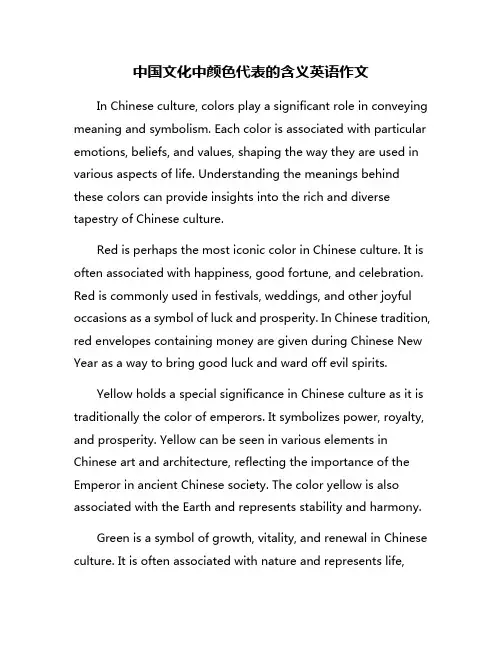
中国文化中颜色代表的含义英语作文In Chinese culture, colors play a significant role in conveying meaning and symbolism. Each color is associated with particular emotions, beliefs, and values, shaping the way they are used in various aspects of life. Understanding the meanings behind these colors can provide insights into the rich and diverse tapestry of Chinese culture.Red is perhaps the most iconic color in Chinese culture. It is often associated with happiness, good fortune, and celebration. Red is commonly used in festivals, weddings, and other joyful occasions as a symbol of luck and prosperity. In Chinese tradition, red envelopes containing money are given during Chinese New Year as a way to bring good luck and ward off evil spirits.Yellow holds a special significance in Chinese culture as it is traditionally the color of emperors. It symbolizes power, royalty, and prosperity. Yellow can be seen in various elements in Chinese art and architecture, reflecting the importance of the Emperor in ancient Chinese society. The color yellow is also associated with the Earth and represents stability and harmony.Green is a symbol of growth, vitality, and renewal in Chinese culture. It is often associated with nature and represents life,youth, and health. Green is commonly used in decorations during the Spring Festival to symbolize new beginnings and a fresh start. In Chinese medicine, green is believed to have a calming effect on the body and mind.Blue is a color that represents tranquility, calmness, and peace in Chinese culture. It is associated with the sky and the sea, symbolizing infinity and the eternal. Blue is often used in religious artwork and temples to create a sense of serenity and spiritual purity. In traditional Chinese painting, blue is used to depict landscapes and scenes of nature, capturing the peacefulness of the natural world.White is a color that symbolizes purity, simplicity, and innocence in Chinese culture. It is often worn during funerals and other mourning ceremonies as a symbol of respect for the deceased. White is also associated with cleanliness and cleanliness, representing honesty and integrity. In traditional Chinese weddings, the bride traditionally wears a white dress to symbolize purity and the beginning of a new life.Black is a color that is often associated with mystery, sophistication, and elegance in Chinese culture. It is also a color of mourning and is worn during funerals to symbolize loss and sadness. Despite its negative connotations, black is also seen as acolor of strength and power in Chinese culture, representing determination and resilience.In conclusion, colors in Chinese culture play a significant role in conveying meaning and symbolism. Each color has its own unique associations and values, shaping the way they are used in various aspects of life. Understanding the meanings behind these colors can provide insights into the rich and diverse tapestry of Chinese culture, helping us appreciate the beauty and complexity of traditional Chinese art, customs, and beliefs.。
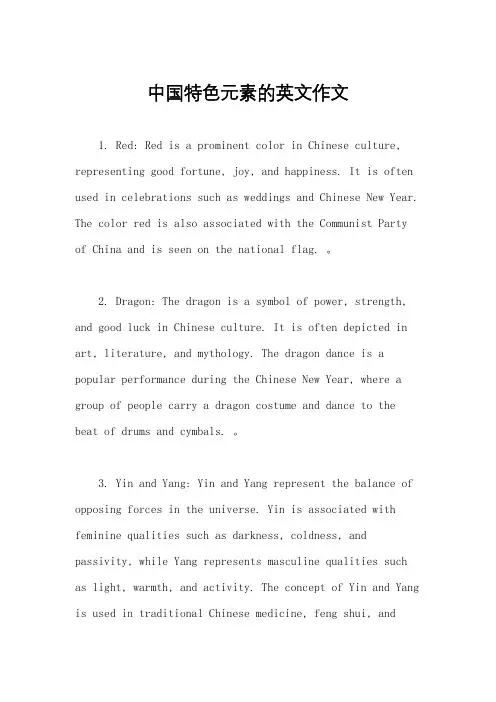
中国特色元素的英文作文1. Red: Red is a prominent color in Chinese culture, representing good fortune, joy, and happiness. It is often used in celebrations such as weddings and Chinese New Year. The color red is also associated with the Communist Party of China and is seen on the national flag. 。
2. Dragon: The dragon is a symbol of power, strength, and good luck in Chinese culture. It is often depicted in art, literature, and mythology. The dragon dance is a popular performance during the Chinese New Year, where a group of people carry a dragon costume and dance to the beat of drums and cymbals. 。
3. Yin and Yang: Yin and Yang represent the balance of opposing forces in the universe. Yin is associated with feminine qualities such as darkness, coldness, and passivity, while Yang represents masculine qualities such as light, warmth, and activity. The concept of Yin and Yang is used in traditional Chinese medicine, feng shui, andmartial arts. 。
了解红色文化英文作文Understanding Red CultureRed has long been a significant color in Chinese culture, symbolizing prosperity, happiness, and good fortune. This vibrant hue has permeated various aspects of Chinese life, from traditional festivals to everyday customs. As the world becomes increasingly interconnected, the understanding of red culture has gained global attention, offering a unique glimpse into the rich heritage and traditions of China.One of the most prominent manifestations of red culture is its prominent role in Chinese festivals and celebrations. The Lunar New Year, also known as the Spring Festival, is perhaps the most well-known example. During this time, red decorations, such as lanterns, scrolls, and banners, adorn homes, streets, and public spaces. The color red is believed to bring good luck and ward off evil spirits, making it a crucial element in the festivities. The tradition of wearing red clothing, exchanging red envelopes filled with money, and setting off firecrackers all contribute to the vibrant and auspicious atmosphere of the Lunar New Year celebrations.Beyond festivals, red culture is deeply ingrained in Chinese daily life. The color red is often used in traditional Chinese architecture, with many temples, palaces, and historic buildings featuring striking red facades and roofs. This bold hue is believed to symbolize the connection between heaven and earth, representing the harmonious balance between the spiritual and the physical realms. The use of red in traditional Chinese art, such as calligraphy and painting, further highlights its significance as a symbol of power, passion, and cultural identity.The influence of red culture extends to the realm of traditional Chinese medicine as well. In Traditional Chinese Medicine (TCM), the color red is associated with the fire element, which is believed to govern the heart and circulatory system. Certain herbs and remedies that are red in color are often used to promote cardiovascular health, regulate blood flow, and enhance overall well-being. The concept of yin and yang, the fundamental principle of balance in Chinese philosophy, is also reflected in the use of red in TCM, as it is seen as a representation of the yang, or the active and masculine, aspect of life.The significance of red culture is not limited to China; it has also gained global recognition and appreciation. In recent years, the popularity of Chinese culture, including its art, cuisine, and traditions, has grown exponentially worldwide. As a result, the understandingand appreciation of red culture have also expanded beyond the borders of China. Fashion designers, interior designers, and artists from around the world have incorporated the symbolic and aesthetic qualities of red into their creations, further spreading the influence of this vibrant hue.Moreover, the understanding of red culture has become an important aspect of cross-cultural exchange and dialogue. As China's global influence continues to grow, the need to understand and appreciate its rich cultural heritage, including the significance of the color red, has become increasingly crucial. This understanding can foster greater mutual respect, cultural awareness, and opportunities for collaboration between China and the rest of the world.In conclusion, the understanding of red culture is a multifaceted and deeply meaningful aspect of Chinese heritage. From its prominent role in festivals and daily life to its influence on traditional medicine and global artistic expression, the color red remains a powerful symbol of the Chinese cultural identity. As the world becomes more interconnected, the appreciation and understanding of red culture can serve as a bridge, connecting people from diverse backgrounds and fostering a greater appreciation for the rich tapestry of Chinese traditions.。
China Red: The Color of Passion and PrideRed has always been a significant color in Chinese culture, symbolizing good fortune, happiness, and prosperity. But beyond these auspicious meanings, red in China also embodies a deeper sense of national pride and identity. Known as "China Red," this vibrant hue has become synonymous with the spirit of the Chinese people, representing their resilience, determination, and unwavering commitment to their country.China Red is ubiquitous in China, appearing everywhere from the grandest palaces to the humblest homes. It adorns the walls of the Forbidden City, where emperors once ruled, and it is the dominant color of the Great Wall, standing as a testament to the strength and endurance of the Chinese nation. In modern times, China Red has been incorporated into the design of everything from Olympic uniforms to public buildings, reflecting the country's desire to project a strong and vibrant image to the world.The significance of China Red extends beyond its visual presence. It is a powerful symbol that evokesdeep emotions among the Chinese people. When they see this color, they are reminded of their rich history and cultural heritage, as well as their shared values and aspirations. China Red represents the unity and solidarity of the Chinese people, their determination to overcome challenges and emerge stronger, and their unwavering commitment to building a prosperous and harmonious society.The influence of China Red is not limited to China itself. It has become a global phenomenon, recognized and appreciated all over the world. Many foreigners associate China with the color red, and it has become a popular motif in fashion, art, and design. China Red has even made its way into the world of sports, with teams from other countries adopting the color to represent their own sense of passion and pride.The enduring popularity of China Red is a testament to its universal appeal and significance. It is a color that transcends cultural and geographical boundaries, speaking to people of all backgrounds and nationalities. In a world that is increasinglyinterconnected and diverse, China Red serves as a powerful reminder of our common humanity and the shared values that bind us together.The significance of China Red is perhaps best illustrated by its use during important national celebrations and events. On occasions like the National Day, the Spring Festival, and the Olympic Games, the color red takes center stage, creating a festive and patriotic atmosphere. People wave red flags, wear red clothes, and display red decorations, all in a show of support and pride for their country. These celebrations are not just about honoring China's past achievements; they are also about looking to the future with optimism and hope.In conclusion, China Red is a color that carries immense significance and emotional weight in Chinese culture. It is a symbol of national pride, identity, and unity, representing the resilience and determination of the Chinese people. Its enduring popularity, both within and beyond China, is a testament to its universal appeal and the deep connection it has with the hearts of people all over theworld. As we move forward into an uncertain and rapidly changing world, China Red serves as a beacon of hope and inspiration, reminding us of our shared humanity and the values that unite us all.译文:中国红:激情与骄傲的颜色红色在中国文化中始终具有重要意义,象征着好运、幸福和繁荣。
颜色在中国文化中的意义英文作文The Significance of Colors in Chinese CultureColors play a profound role in Chinese culture, symbolizing various emotions, values, and beliefs. They are not just visual representations but also carry deep cultural and historical meanings.Red, the color of luck and prosperity, is highly revered in Chinese culture. It is often associated with celebrations and festivals, such as weddings and the Spring Festival. The red color is believed to bring good fortune and ward off evil spirits. In traditional Chinese weddings, the bride typically wears a red dress, symbolizing happiness and purity.Yellow, the color of royalty and dignity, holds a special place in Chinese history. It has long been associated with the emperor and the imperial family, representing their power and authority. The use of yellow in clothing and decorations was strictly reserved for the imperial court.White, on the other hand, represents purity and innocence. It is often used in funeral ceremonies, symbolizing peace and mourning. In Chinese art and calligraphy, white space is crucial, as it complements and enhances the colors and shapes.Green, associated with nature and growth, is seen as a symbol of harmony and renewal. It is often used in traditional Chinese paintings to depict landscapes and gardens.Blue, though not as prominent as other colors in Chinese culture, is sometimes associated with tranquility and serenity. It is often found in traditional Chinese artworks, adding a sense of calmness and balance.In conclusion, colors in Chinese culture are not just aesthetic choices but also carry rich cultural and historical meanings. They reflect the values, beliefs, and traditions of the Chinese people, making them an integral part of the culture. Understanding the significance of colors in Chinese culture helps us appreciate its depth and uniqueness.。
中国红初三英语作文China Red。
China Red is a traditional color in Chinese culture, symbolizing happiness, prosperity, and good luck. It is a color that can be seen everywhere in China, from decorations during festivals to the iconic red lanterns hanging on the streets. As a Chinese student in the third year of junior high school, I have always been fascinated by the significance of China Red and its role in our daily lives.One of the most common uses of China Red is during the Chinese New Year, also known as the Spring Festival. During this time, people decorate their homes with red couplets, paper cuttings, and lanterns to bring good luck and ward off evil spirits. The color red is believed to bring prosperity and happiness to the household, making it an essential part of the festive decorations.In addition to the Chinese New Year, China Red is also commonly seen in traditional Chinese weddings. The bride often wears a red dress, symbolizing joy and good fortune, while the groom may wear a red tie or sash. Red is considered an auspicious color for weddings, as it is believed to bring happiness and prosperity to the newlyweds.Furthermore, China Red is also used in traditional Chinese architecture and design. Many ancient temples and palaces are adorned with red pillars, doors, and windows, symbolizing power and prestige. The color red is also commonly used in traditional Chinese paintings and calligraphy, adding a touch of elegance and sophistication to the artwork.Moreover, China Red is not only a symbol of tradition and culture but also a source of inspiration for modern Chinese artists and designers. Many contemporary artists incorporate the color red into their works, creating bold and vibrant pieces that reflect the rich cultural heritage of China. From fashion to interior design, China Red continues to influence and inspire creativity in various fields.In conclusion, China Red holds a special place in Chinese culture, representing happiness, prosperity, and good fortune. From traditional festivals to modern art, the color red plays a significant role in our daily lives, reminding us of our rich cultural heritage and traditions. As a Chinese student, I am proud to embrace China Red and all that it symbolizes in our society.。
中华文化中颜色代表的含义英语作文全文共6篇示例,供读者参考篇1The Colorful Meanings in Chinese CultureHi everyone! My name is Lily and I'm going to tell you all about the cool meanings behind different colors in Chinese culture. Colors are super important in China and they stand for different things. Let me share what I've learned!RedLet's start with the color red because it's one of the most important colors in China. Red is considered a very lucky color. It symbolizes happiness, success, luck, and life. That's why red is used a lot during Chinese New Year and other holidays and celebrations. People decorate with red lanterns, wear red clothes, and give gifts in red envelopes with money inside called "hongbao." Red is also popular at Chinese weddings because it represents love and bringing new life into the world. Pretty neat, huh?YellowAnother important color is yellow. In China, yellow is the color of the emperor and royalty. It stands for power, wealth, and honor. A long time ago, only the emperor was allowed to wear yellow robes and live in the yellow buildings inside the Forbidden City in Beijing. Temples and imperial buildings were often painted yellow too. My favorite thing about the color yellow in Chinese culture is that baby boys used to wear yellow hats and clothing to wish them a future of wealth and high status!GreenGreen is a color that represents nature, growth, fertility, and good luck. Lots of plants are green of course, so green reminds people of spring and new life blossoming. Some people say wearing green clothes can help grow wealth and prosperity. I think it's really cool that in Chinese mythology, the Emperor of the East rules over the spring season and his symbol is a green dragon! Green is definitely a popular color during Spring Festival.BlueDid you know that the color blue doesn't have a huge history in Chinese culture? Blue dyes and pigments were really hard to make in ancient times, so the color blue wasn't seen or used篇2The Colorful World of Chinese CultureHi friends! Today I want to tell you all about the super cool meanings of colors in Chinese culture. In China, colors aren't just colors - they represent important ideas and have special symbolism. Isn't that awesome? Let me explain what the different colors mean.RedOhh, red is my favorite color! In Chinese culture, red is considered the luckiest color. It symbolizes happiness, joy, and good luck. Red is an important color for celebration and festivals like Chinese New Year. During New Year, red decorations are hung everywhere to welcome the new year with luck and prosperity.Brides wear red dresses on their wedding day because red means love and fertility. Little red envelopes filled with money are given as gifts during holidays and special occasions, bringing good wishes to the receiver. When you see red in China, it means energy, celebration and pure happiness!YellowThe color yellow is really meaningful in China too. It represents royalty, power and nobility. A long time ago, only the emperor was allowed to wear yellow clothes and use yellow glazed roof tiles on palaces. Yellow symbolizes neutrality, calmness and wisdom.Have you ever heard of the Yellow River? It's a hugely important river in China's history that is sometimes called "the Mother River." The Chinese people were one of the earliest to use the yellow color to symbolize earth and the golden wheat and soil that give life. So yellow has a warm, bountiful energy for the Chinese.GreenGreen is the color of nature, just like in Western cultures. It represents growth, harmony, fertility and renewal in Chinese thought. Green reminds people of the lush bamboo forests, vibrant mountains, and abundant plant life across China's landscapes.The Chinese character for "green" is made up of two parts - one meaning "life" and the other meaning "plant". How cool is that? Green jade is a beloved gemstone from ancient times representing virtue, beauty and grace. Overall, green has peaceful, fresh vibes associated with it in Chinese symbolism.BlueWhile red is the luckiest color, blue is seen as the color of immortality and cosmic energy in China. The azure blue sky and deep blue from natural sources like the blue dye from plant roots give blue its spiritual meaning. Blue reminds people of the infinite universe and the pursuit of enlightenment.Have you heard of the amazing blue and white ceramic porcelain from China? It's world famous! The blue decorations on white porcelain represent ideas like truth, natural law, and the universal order. For clothing, blue represents moderation and cultivated gentleness. The soft, transcendent blue color embodies higher ideals.WhiteYou might think white is just a plain color, but it's actually super meaningful too! White is the color of purity, cleanliness and hope in Chinese symbolism. White represents new beginnings and a fresh start, which is why white is a common color for mourning clothes at funerals.After someone passes away, the family enters a period of purification by wearing white and abstaining from celebrations for a while. White lotuses are a beautiful white flowerrepresenting purity of mind and spirit. Brides accessorize with white as well on their wedding day as a symbol of joy and light. Pretty meaningful, right?BlackLast but not least, let's learn about the color black. Black represents openganism, modernity, sophistication and formality in Chinese culture. It conveys a sense of sternness, seriousness and authority. Black is considered the most formal color for young men to wear in traditional Chinese clothing.Black ink used for Chinese calligraphy ink paintings represents the beauty of black and gives a classic, timeless elegant vibe. Black and white color schemes are incredibly popular for home decorations and fashion in modern China today. While once associated with sadness, black is now embraced as a high-class, urbane color.Phew, that was a lot of information about colors! As you can see, these colors have really unique, symbolic meanings woven into China's customs and ways of thinking about the world. They aren't just surface level - colors truly express the depths of Chinese philosophy and cultural identity.I hope you found this introduction to the symbolic colors fascinating! Which color resonates with you the most after learning about their meanings? For me, I'm still loving red the most because of its energy and association with luck and joy. Let me know your favorite color meaning in the comments!篇3The Meanings of Colors in Chinese CultureColors are everywhere around us! They make the world so bright and beautiful. Did you know that in Chinese culture, different colors have different special meanings? Let me tell you about some of the most important colors and what they mean.RedOne of the most important colors in Chinese culture is red. It is considered a very lucky color. Red is the main color for Chinese New Year celebrations. During that holiday, red decorations are put up everywhere to bring good fortune for the coming year. Red is also very popular for weddings because it symbolizes joy, virtue, truth, and sincerity. Brides in China traditionally wear a red dress or have red in their outfit in some way. Red is just an overall happy, auspicious color.YellowThe color yellow is also very meaningful in Chinese culture. It is considered the most beautiful and prestigious color. In ancient times, only the emperor was allowed to wear yellow clothes and yellow was the color of the imperial family. Even today, yellow represents freedom, franquility, and enlightment. It also symbolizes earth, harvests, and the season of fall. The yellow chrysanthemum is an important floral symbol too.GreenThe color green represents new life, health, fertility, and renewal in Chinese culture. It also symbolizes money, prosperity, and wealth. Green is a very healing, refreshing color that reminds people of nature. It stands for peace, growth, and independence. In popular sayings, green hats are worn by men whose wives have been unfaithful, but other than that, green is a very positive color.PurplePurple has very different meanings compared to the West. In China, purple represents wealth, status, and privilege. It is a luxurious color that signifies power and ambition. Purple clothing was reserved only for the royal families. Now the colorpurple represents dignity, spirituality, and traditionally masculine values as well. It also symbolizes randomness, irregularity, and the unknown.BlackThe color black is associated with water and careers in Chinese culture. It represents formality, modesty, and calmness. Black clothing is worn for funerals or mourning periods. However, black also signifies strength, security, and impartiality. It is a neutral color that allows the inner beauty to show through. Names with the character for "black" mean power, heaven, and excellence too.WhiteWhite is a very significant color in China. It symbolizes purity, cleanliness, and perfection. White clothing is worn by brides and at funerals. White chrysanthemums represent grief and sadness. White is also associated with metal, autumn, and the west. However, white can also mean innocence, brightness, and freshness, which are positive qualities. White is considered the perfect canvas or blank slate in the arts.BlueThe color blue has both positive and negative meanings in Chinese culture. On the positive side, blue is associated with wood, spring, and eastern directions. It represents health, healing, and peacefulness. Dark blue symbolizes immortality. However, blue also represents depression, sadness, and death. It is an unlucky color to incorporate into events like weddings. Overall though, blue has more positive connotations.As you can see, colors play a huge role in China's customs, arts, and traditions. They are symbols packed with layers of cultural significance going back thousands of years. Chinese people give a lot of thought about what colors mean and express through their color choices. The next time you see a certain color used a lot, think about what deeper meaning it might hold! Understanding color meanings helps you understand Chinese culture better.篇4Colors are More than Just Colors in Chinese CultureHello friends! Today I want to tell you about something very interesting and important in Chinese culture – the meanings behind different colors. In China, colors are not just colors. Theystand for different things and have deep meanings. Isn't that cool? Let me share what I've learned!RedLet's start with red, because red is a really big deal in China! You see red everywhere during Chinese New Year. Red is considered a very lucky color. It represents happiness, wealth, and good fortune. Red is so auspicious that Chinese brides wear red dresses on their wedding days to invite luck and prosperity into their marriages. How neat is that?Some other things red means are joy, celebration, and courage. When you see red lanterns or red envelopes (hongbao), it means festivities and cheer are here! Red is also the color of fire, which is why it symbolizes courage and enthusiasm. Pretty awesome, right?YellowAnother major color in Chinese culture is yellow. Yellow is the color of the earth, so it stands for harvests and fertility. It also represents freedom from worries, and having a smooth, bright future ahead. The royal color during ancient times was yellow too. Only emperors could wear yellow robes! So yellow means power and royalty as well.Isn't it funny how a color can mean so many different things? Like red, yellow symbolizes warmth, energy, and cheer. That's why decorations during big Chinese festivals often use a lot of red and yellow tones.GreenGreen is my favorite color, what's yours? In Chinese culture, green stands for new life, new beginnings, freshness, and growth. It represents the life force of nature, like the green shoots pushing up through the soil in spring. Green is a peaceful, calm color. It symbolizes good health, harmony, and balance.Green is also connected to education and learning new things. That's because green stands for a youthful mind that is open to developing and understanding the world. How fitting for us students, right? Let's keep our minds green and thirsty for knowledge!BlueBlue might be a cool color, but in Chinese thought, it isn't the luckiest one. Blue can represent the pure sincerity of nature, like an endless blue sky. However, it is also linked with cold, sadness, and even infertility. Blue means heaven in Chinese,which seems positive. But heaven was seen as a lonely, remote place by ancient thinkers.So in summary, blue is a complicated color with mixed meanings. Some positive connections are wisdom, clarity, spirituality, and immortality. But it can also imply misfortune, depression, and introversion. Not totally bad, but not the best color meaning either!WhiteWhat does the color white make you think of? Purity, simplicity, cleanness? Those meanings apply in Chinese culture too. White represents purity, brightness, freshness, and neatness. It symbolizes an open, honest, and straightforward approach to life.At Chinese funerals, the deceased person's family members wear white clothes and headbands. This is to represent purity, mourning, and bidding farewell. On the other hand, white is an auspicious color for weddings! The bride's white dress stands for her innocence and virtue. Mixed meanings again, just like blue.BlackLast but not least, let's talk about the color black. In China, black symbolizes a few different things that might surprise you!First, it signifies wealth, prosperity, and good fortune. This links to its connection with water, an essential resource for agriculture. Black clothing was worn by wealthy people in the past.However, black also means bad luck, negativity, and destruction. It's associated with fear and evil spirits in Chinese folklore. At Chinese funerals, black decorations, clothes, and candles signify death and mourning. So black has some very contrasting meanings in Chinese thinking!Isn't it amazing how colors can stand for so much more than their basic hues? Colors play a huge part in representing concepts, emotions, and beliefs across Chinese culture and traditions. The next time you see colors used, think about their deeper symbolism and significance. Colors are not just colors –they are a vivid language of their own! Thanks for reading, my friends. I hope you enjoyed learning about the poetic meanings behind Chinese colors as much as I did.篇5Colors in Chinese CultureHi everyone! Today I want to talk about colors and what they mean in Chinese culture. Colors are super important in China andeach color has its own special meaning. Let me tell you about some of the most common colors and what they represent.RedThe first color I want to talk about is red. In China, red is considered the luckiest color! It stands for good fortune, joy, and happiness. That's why red is everywhere during Chinese New Year - red lanterns, red envelopes with money inside, red decorations, and more. Red is bright and eye-catching, like a stoplight that makes you take notice.Folks in China love wearing red for important events like weddings and birthdays because it's supposed to bring good luck. Kids even wear red underwear or have a red bracelet for protection from evil spirits. How cool is that?When I was little, my grandma always gave me a red envelope with money on Chinese New Year. It was her way of wishing me a year filled with happiness and prosperity. Red is definitely the most popular color in China!YellowThe next color that's really meaningful is yellow. You might think of bright yellow as a cheery, sunny color. But in China, yellow is actually the color of royalty and power. A long time ago,only the emperor was allowed to wear yellow clothes or live in a yellow palace.My history teacher told us about how yellow represented the sacred and noble. Members of the royal family decorated their homes with lots of yellow items to show their high status. They even put yellow glaze on fancy pottery because yellow was so precious.These days, young people in China don't think of yellow as only for emperors though. A lot of my friends like dressing in yellow during springtime when nature is blooming and full of yellow flowers. It reminds them of sunshine and cheerfulness.GreenDo you like the color green? I sure do - especially lighter shades of green like emerald or olive. Green is another lucky color for Chinese people that represents growth, harmony, and fertility. Can you guess why?That's right - because of nature! Trees, plants, and crops are all green. So green reminds Chinese folks of spring, new life, and an abundant harvest. Ancient Chinese people believed the bright green bamboo plant brought them good health and peace.My grandparents always decorate with fresh green plants during important holidays or family gatherings. They say it creates a feeling of balance and renewal in the home. Some people even wear jade green jewelry or clothes because they think it will bring them good fortune.PinkOkay, here's a fun color - pink! You might imagine pink is a feminine, girly color, right? Well that's true in Chinese culture too. Pink stands for good health, calmness, and sweet things like romantic love.Pink used to only be for girls and women, but nowadays Chinese guys don't mind wearing pink either. I have a pink baseball cap that's my favorite. My big brother always teases me about it, but I think he's just jealous because I look so fresh in pink!Chinese brides often incorporate pink into their wedding dress or decorations. Pink represents universal love and harmony between the new husband and wife. How romantic is that? Plus, doesn't a pink cake or pink lemonade just sound delicious?WhiteLast but not least, I'll tell you about the color white. While white can mean purity and cleanliness in China, it also is connected to death and mourning. That might seem like a bummer, but it makes篇6The Colorful World of Chinese CultureColors are so cool! They make the world a much brighter and prettier place. But did you know that in Chinese culture, different colors can have very special meanings? Learning about the meanings behind colors helps me understand my family's traditions better. Let me tell you what I've learned!Let's start with the color red. In Chinese culture, red is considered the luckiest color. It represents happiness, prosperity, and good fortune. That's why you'll see red everywhere during Chinese New Year! My grandparents give me and my cousins little red envelopes stuffed with money to wish us a lucky new year. Chinese brides also wear red dresses on their wedding days for good luck in their marriages.Another lucky color in Chinese culture is yellow. Yellow symbolizes royalty, power, and freedom from worldly worries. Maybe that's why the bright yellow sun feels so warm and happy!Imperial palaces in Ancient China used a lot of yellow decorations to represent the emperor's golden royalty. My dad told me that only people связанный с the royal family were allowed to wear yellow back then.Speaking of royalty, the color purple is also associated with the emperor and the elite upper classes. In China, purple represents wealth, nobility, and wisdom. I think that's really cool that a color can mean all those important things! You'll find shades of purple all over the architecture and artwork inside palaces, temples, and important buildings.Green is one of my favorite colors, and in Chinese culture, it stands for new life, growth, fertility, and renewal. The color green reminds me of the first shoots popping up after winter, or the bright green leaves returning to the trees in spring. Green is such a reviving and refreshing color. So it makes perfect sense that green symbolizes good health, harmony, and new beginnings in China.The color white has very different meanings in Chinese culture compared to Western cultures. While a white wedding dress represents purity and innocence in the West, white is actually the traditional color for mourning in China. White symbolizes death and sadness. But it can also mean purity,cleanliness, and simplicity in some contexts. I guess white has more serious connotations overall.Meanwhile, the color black is associated with things like evil, cruelty, and bad omens in Chinese culture. Black is the color of fear, mystery, and the unknown. How spooky is that? But black also represents formality, dignity, and high sophistication for things like business attire or fancy events. It's like black has a strict, no-nonsense meaning.Blue isn't as prominent of a color in traditional Chinese culture. But some of its symbolic meanings are truth, fidelity, and heaven. Maybe that's why the blue sky on a sunny day always feels so peaceful and calming to me. But blue can also represent immortality and even sadness or depression in certain contexts.Finally, I want to talk about the color orange. In China, orange represents good fortune, prosperity, and joy. It's considered an extremely auspicious color. My grandparents say eating oranges and displaying orange decorations during Chinese New Year will bring our family lots of happiness and luck for the new year ahead! I love eating those sweet, juicy oranges.Learning all these symbolic color meanings from my parents and grandparents helps me appreciate my Chinese heritage so much more. Colors play such an important role in Chinesecustoms, festivals, beliefs, and ways of life. Isn't it amazing how many layers of cultural richness are contained within something as simple as a single color? The next time I see a vibrant array of colors, I'll think about all their deeper Chinese symbolic meanings too. What a colorful world!。
绿色是中国文化英文作文英文:Green is an important color in Chinese culture. It represents nature, fertility, and harmony. In traditional Chinese culture, green is associated with the spring season, which symbolizes new beginnings and growth. For example, during the Qingming Festival, people visit the graves of their ancestors and offer green vegetables as a way tohonor the deceased and bring good luck to their families.In addition to its symbolic meanings, green is also a popular color in Chinese art and architecture. Traditional Chinese paintings often feature lush green landscapes,while green tiles are commonly used in the roofs of ancient buildings. This use of green reflects the Chinese people's deep connection with nature and their desire to live in harmony with the environment.Furthermore, green is also a color of good luck inChinese culture. It is often associated with wealth and prosperity. For example, during the Chinese New Year,people decorate their homes with green plants and weargreen clothing to attract good fortune for the coming year.In my personal experience, I remember my grandmother always emphasizing the importance of eating greenvegetables for good health. She used to say, "青菜萝卜,各有所爱" (qīngcài luóbo, gè yǒu suǒ ài), which means "different strokes for different folks" in English. This shows how the color green is deeply ingrained in Chinese wisdom and everyday life.Overall, green holds a special place in Chinese culture, representing nature, growth, and good fortune. Its significance can be seen in various aspects of Chinese life, from traditional festivals to everyday customs.中文:绿色在中国文化中具有重要意义。
Color in Chinese culture
李曼琳 0940120 Color in Chinese culture refers to the various colors that are considered auspicious or inauspicious. The Chinese character for color is 顏色(yánsè). In ancient China, the character more accurately meant color in the face. During the Tang Dynasty, yánsèbegan to refer to all color.
In traditional Chinese art and culture, black, red, blue-green, white and yellow are viewed as standard colors. These colors correspond to the five elements of water, fire, wood, metal and earth, taught in traditional Chinese physics.
· Black
Black, corresponding to water, is a neutral color. The I Ching, regards black as Heaven’s color. The Taiji symbol uses black and white to represent the unity of Yin and Yang. Ancient Chinese regarded black as the king of colors and honored black longer than any other color. And the Dao School chose black as the color of the Dao. In modern China, black is used in daily clothing. And in some area, black may also be used during a funeral to symbolize the spirit's return to the heavens. A black ribbon is usually hung over the deceased's picture.
· Red
Red, corresponding with fire, symbolizes good fortune and joy. And there is a red complex of Chinese. The ancient Chinese thought that red stems from the sun, because of hot sun like fire, they depended on and worshiped to the sunlight. They knew only under the red sunshine, things can be full of vitality. In this cultural context, the prosperous red color naturally has had the jubilation and propitious meaning. During Chinese New Year and other holidays and family gatherings, red can be found everywhere. And red is strictly forbidden at funerals as it is a traditionally symbolic color of happiness.
In modern China, red remains a very popular color and is affiliated with and used by the Communist government.
· Blue-Green
Blue-green, corresponding with wood, represents nature and renewal and often indicates spring. The color implies vigor and vitality. Its base colors also have distinct meanings.
Generally green is associated with health, prosperity, and harmony. However, green hats are associated with infidelity and used as an idiom for a cuckold. Blue symbolizes immortality.
· White/Silver
White, corresponding with metal. Unlike the Western meanings of purity, chastity, holiness and cleanliness, in China white is associated with death and is used predominantly in funerals in Chinese culture. Ancient Chinese people wore white clothes and hats only when they mourned for the dead. Sometimes silver takes its place, as silver is often offered to the deceased in the form of joss paper.
· Yellow/Gold
Yellow, corresponding with earth, is considered the most beautiful color and is the symbol of noble. The Chinese saying, Yellow generates Yin and Yang, implies that yellow is the center of everything. Yellow signifies neutrality and good luck. Yellow is sometimes paired with red in place of gold.
In ancient times, Yellow was the color of Imperial China and is held as the symbolic color of the five legendary emperors of ancient China. Yellow often decorates royal palaces, altars and temples, and the color was used in the robes and attire of the emperors.。